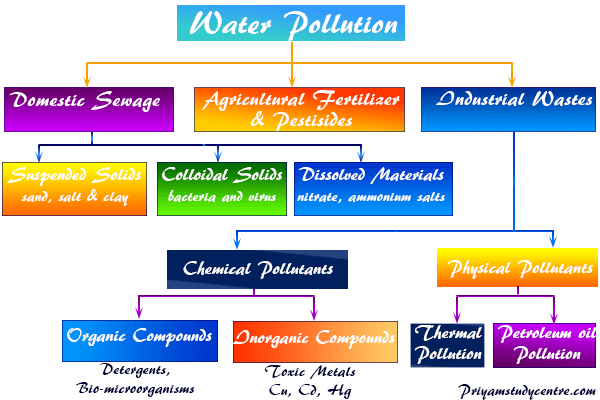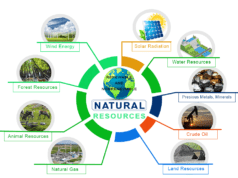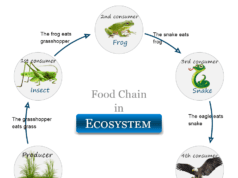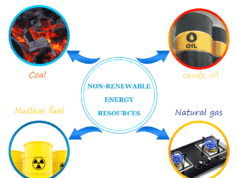Sources of Water Pollution
Water pollution sources such as insoluble solid particles, soluble salts, sewage, garbage, radioactive substances, industrial wastes, algae, and bacteria can causes adverse effects on our environment and human health. These substances go into the surface of ground water or into the rivers, lakes, streams, and oceans. Therefore, water gets polluted or these substances interfere with the natural functioning of the water molecules in our environment and human health. In addition to the above substances, the sources of water pollution may include disease producing microorganisms and heat from thermal energy or nuclear power generation plants. Therefore, we need proper solutions to prevent water pollution caused by such substances. According to the polluted sources, it can be classified into the following types given in the picture,

Industrial Water Pollution
The wastes discharged by the industries are called industrial wastes. Industrial wastes contain the compounds of metals (mercury, cadmium, lead, etc), and organic compounds (alcohol, aldehydes, ketones, etc).
Industrial wastes and sewage mainly contain organic compounds. These are used as food by bacteria which rapidly increases the population of bacteria in water. These bacteria oxidize nitrogen and phosphorus present in organic compounds.
The oxidation process consumes large quantities of oxygen gas dissolved in water. The loss of dissolved oxygen from water causes water pollution to the death of fish and other aquatic life present in lakes, streams, rivers, and oceans.
Water Pollution Causes and Effects
Water bodies can be polluted by different types of sources such as industrial wastes, organic sewage wastes, chemical fertilizers (plant nutrients), disease producing microorganisms, toxic chemicals, sediments, heat, petroleum oil, etc. The causes and effects of water pollution on human health or the environment are discussed in this learning chemistry article.
Causes of Water Pollution
- The large quantities of sewage discharged into rivers and lakes causes water pollution in our environment. This sewage is produced by everyday human activities such as bathing, washing clothes, and excreting urine and feces.
- Organic pollutants contain synthetic detergents, herbicides, toxic pesticides, etc. The detergents are surfactants or organic compounds having hydrophilic or lyophilic groups soluble in water. Therefore, they have the properties to cause water pollution.
- Builders generally throw sodium salts of phosphoric acid, carbonic acid, sulfuric acid, and nitric acid into the water causing water pollution.
- Toxic pesticides such as D.D.T, endrin, dieldrin, B.H.C, and polychlorinated biphenyls are other sources of water pollution. These types of water pollution sources have adverse effects on fish or aquatic life that live in rivers, lakes, and streams.
- Thermal power plants and crude petroleum oils also cause polluted water in our environment.
Effects of Water Pollution
The adverse effects of water pollution on human health, animals, plants, and aquatic life are seen in several ways.
- It has adverse effects on ground drinking water used by human beings and animals. Therefore, it creates many health problems in several regions of the world.
- The substances obtained from sewage contain organic compounds. It acts as food for food bacteria present in the water of lakes and rivers. Therefore, the population of bacteria in the water is rapidly increasing. It consumes a large quantity of oxygen in river water. The loss of dissolved oxygen in river water has adverse effects on the aquatic life of our environment.
- The surfactants produced by organic compounds are not decomposed by bacteria. It has adverse effects on water. Therefore, large quantities of detergent foams are collected in lakes and rivers.
- To increase the production of crops, we use large quantities of nitrate and phosphate fertilizers and pesticides. The excess use of nitrate or phosphate fertilizer is washed away from the agricultural lands into the ponds, lakes, and rivers. Therefore water and soil get polluted by this process.
- The inorganic complexes act as plant nutrients. It causes the rapid growth of algae. The rapid growth of algae causes green sludge on the surface water.
Effects of Wastewater
The wastewater coming from the chemical and fertilizer industry contains nitrate and phosphate compounds. It has harmful effects on human health and aquatic life in rivers, lakes, and seas.
The presence of fertilizers in the polluted water increases the growth of algae and other aquatic plants. The polluted water containing nitrate salts is not suitable for human health. Therefore, we cannot use such types of polluted water for drinking purposes.
Effects of Acid Rain on Water
The polluted air contains sulfur dioxide (SO2) that undergoes photolytic and catalytic oxidation to form SO3. SO3 and NO2 from our environment react with rainy water or moisture to form sulfuric or nitric acid rain. These are also the secondary facts that effects water and soil pollution.
Disease Caused by Microorganisms
The disease producing microorganism that comes from the residents of a municipality are transmitted through water suppliers and produce several types of diseases in living beings (animals or humans).
Such polluted sources can causes water pollution in our environment. Therefore several types of diseases such as dysentery, typhoid, and cholera caused by microorganisms are transmitted through polluted water.
Ground Water Pollution
Ground water is the main source of drinking water for many peoples. Many regions of the United States depend mainly on groundwater for their domestic supply.
Due to several human activities, the groundwater gets polluted by dissolving toxic chemical elements, substances, bacteria, and viruses. Therefore, due to water pollution, sources of safe drinking water are the most common problem in many cities in different countries like the United States, England, India, Germany, etc. People use water reverse osmosis purifiers to survive the problems of water pollution.
Thermal Pollution
Thermal pollution in our environment affects mainly the aquatic life present in lakes, rivers, reservoirs, seas, etc. Heat can decrease the capacity of dissolved oxygen in rivers, lakes, or seas which increases the metabolism of fish. Some fishes cannot be alive with very low levels of dissolved oxygen.
The main source of heat comes from the cooling water of power plants into rivers. The polluted water is much warmer than naturally occurring water bodies.
Oil Pollution in Water
A large quantity of crude petroleum oil is spilled accidentally or intentionally into the sea water from the tankers (ships) or during the drilling operation causes water pollution in the sea.
For example, the accidental leakage of 118,000 tonnes of crude petroleum oil from the big oil tankers (Torrey Canyon) into the water of the English Channel polluted the water of the surrounding area in a few hour’s time.
Effects of Oil Spills on the Environment
The oil is lighter than water, oil forms a layer on the surface of the water which is called oil sticks. The oil spills prevented dissolving oxygen in the water which has adverse effects on aquatic life.
Oil pollution effects the growth of plankton which disrupts the entire cycle of marine life present is seas. Plankton is a layer of tiny animals and plants that live on the surface of the sea.
Water Pollution in the Ocean
The effect of global warming or climate change also reduces the dissolved oxygen in the ocean’s water. Due to ocean water pollution, some coastal areas formed dead zones where the dissolved oxygen is at very low levels. Therefore, most of the higher forms of aquatic or water life are vanish. The Gulf of Mexico is the largest dead zone (22,730 square kilometers) in the world.
Solutions for Water Pollution
- The sources of water pollution can be controlled or prevented by the minimum use of excess nitrate and phosphate fertilizers. Minimum use of synthetic detergents, or bio-degradable detergents. Bio-degradable detergents are substances that can be decomposed by bacteria.
- Water pollution sources can be controlled, before throwing industrial wastes and sewage into the river and lakes. The inorganic or organic substances are first treated chemically to neutralize the harmful substances present in them.
- The radioactive waste products obtained from nuclear power plants, hospitals, and scientific laboratories should be enclosed in containers made of concrete. It is dumped into the seawater to control such sources of water pollution.








